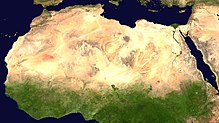Land management has preserved the natural characteristics of Hopetoun Falls, Australia while allowing ample access for visitors.
Satellite image of the Sahara desert; the world's largest hot desert and third-largest desert after the polar deserts.
- Complete ecological units that function as natural systems without massive civilized human intervention, including all vegetation, microorganisms, soil, rocks, atmosphere, and natural phenomena that occur within their boundaries and their nature.
- Universal natural resources and physical phenomena that lack clear-cut boundaries, such as air, water, and climate, as well as energy, radiation, electric charge, and magnetism, not originating from civilized human activity.
People seldom find absolutely natural environments on Earth, and naturalness usually varies in a continuum, from 100% natural in one extreme to 0% natural in the other. More precisely, we can consider the different aspects or components of an environment, and see that their degree of naturalness is not uniform.[2] If, for instance, in an agricultural field, the mineralogic composition and the structure of its soil are similar to those of an undisturbed forest soil, but the structure is quite different.
Natural environment is often used as a synonym for habitat. For instance, when we say that the natural environment of giraffes is the savanna.






No comments:
Post a Comment